(Hastings-on-Hudson, New York, August 31, 1891 – January 25, 1949, Dade County, Florida).1
Devery’s father worked as an engineer for New York City’s Board of Transportation.2 John Joseph Devery, Jr., upon completing high school in 1912, also went to work as an engineer, “spending four years . . . doing work on the subway tunnels under the East river in New York and other important undertakings, in some of them where it was necessary to work under compressed air.”3
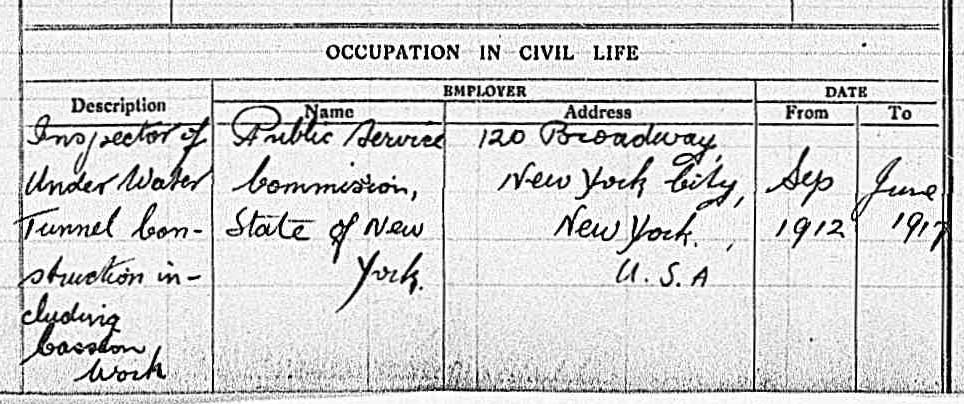
His R.A.F. service record notes that from 1912 to 1917 he was an “Inspector Under Water Tunnel Construction including Cassion [sic] Work” for the Public Service Commission of New York, and also that he had a “Knowl. of Automobile Motors.”4 He attended ground school at the University of Texas, graduating August 25, 1917.5 He planned to marry Agnes Culleton in October, but, when he was ordered to Mineola preparatory to departure for Italy, as it was thought, the wedding was moved up to September 2, 1917.6
With the 150 men of the “Italian” or “second Oxford detachment” Devery sailed to England on the Carmania, which left New York for Halifax on September 18, 1917, and departed Halifax as part of a convoy for the Atlantic crossing on September 21, 1917. Devery’s cabin mates on board were William Ludwig Deetjen, Leonard Joseph Desson, and Philip Dietz. When the Carmania docked at Liverpool on October 2, 1917, the men learned that they were not to proceed to Italy, but to remain in England, where they would attend ground school (again) at the Royal Flying Corps’s No. 2 School of Military Aeronautics at Oxford University. On November 3, 1917, Devery travelled with most of the detachment to Harrowby Camp near Grantham in Lincolnshire to attend machine gun school.
While fifty of the men at Grantham were sent on to flying schools on November 19, 1917, the rest, including Devery, continued their course at Harrowby Camp through the end of November. On November 29, 1917, they celebrated Thanksgiving in great style, with many of the men who were already at flying schools coming in to join them. Festivities included a football game between the “Unfits” and the “Hardly Ables.”8 Devery played for the winning Unfits and appears in photos of the team taken that day.9
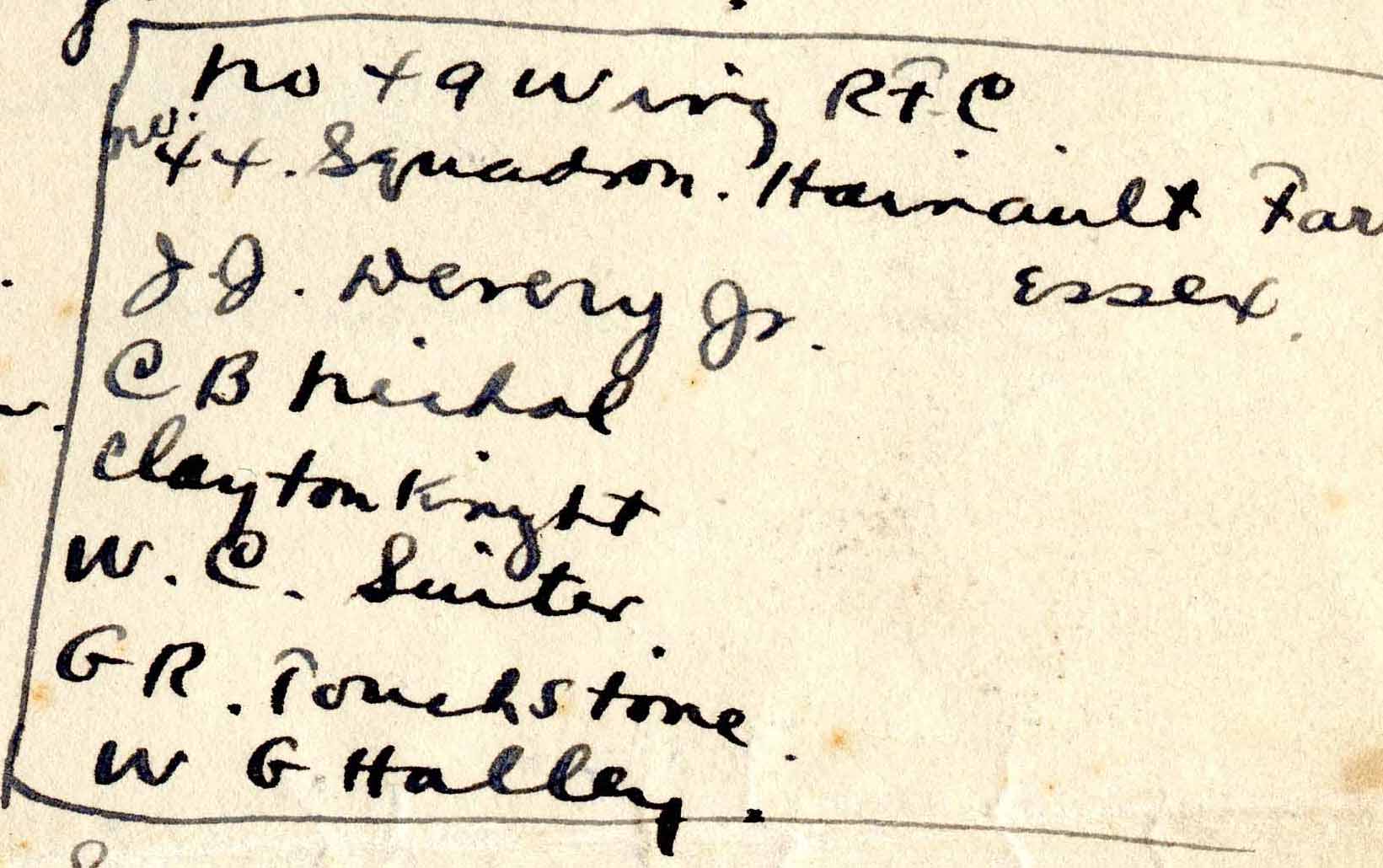
A few days later, on December 3, 1917, all of the men still at Grantham were posted to flying squadrons, and Devery, along with Walter Ferguson Halley, Clayton Knight, Clark Brockway Nichol, Wilbur Carleton Suiter, and Grady Russell Touchstone, was assigned to No. 44 Squadron, a home defense squadron at Hainault Farm in Essex.10 Knight, who was billeted with Devery, described their time at 44, where “there was absolutely no formality in the Mess, in contrast to our experiences at Oxford and Grantham.” The regular pilots of No. 44 flew Camels, but there was a B.E.2c used for training.11
At the end of January 1918 the men at No. 44 were “posted away to a regular flying training unit at Stamford,”11a almost certainly to No. 5 T.D.S. at Easton on the Hill a mile or so southwest of Stamford. Devery’s presence there is documented by an entry in the diary of Hilary Baker Rex, who lists Devery as among the pall bearers at the funeral of their fellow second Oxford detachment member Clark Brockway Nichol, killed at 5 T.D.S. on February 18, 1918.11b Devery’s R.A.F. service record suggests that he was moved again in early March.12
Devery was recommended for his commission around the beginning of April; Pershing’s cable forwarding the recommendation is dated April 8, 1918. The confirming cable from Washington is dated May 13, 1918, and later that month Devery was sworn in and placed on active duty (there was considerable grumbling among the men because their commissions were coming through so slowly).13 Meanwhile, on May 1, 1918, Devery reported to No. 5 Training Depot Station at Easton on the Hill, a couple of miles southwest of Stamford.14
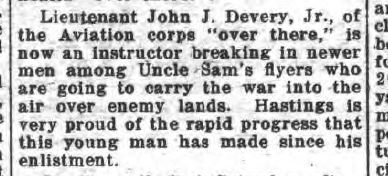
Brief accounts of his doings based on his letters home were published in a local newspaper, and one of these indicates that around this time he was, like William Thomas Clements, serving as an instructor.15 His R.A.F. service record puts him (without a date) at No. 26 Training Squadron (Narborough, Norfolk) before he was sent to No. 2 Fighting School at Marske on August 10, 1918.
Devery, along with fellow second Oxford detachment member Albert Elston Weaver, reported to the U.S. 166th Aero Squadron at Colombey-les-Belles on September 20, 1918 (Paul Vincent Carpenter, Harrison Barbour Irwin, and Perley Melbourne Stoughton arrived a few days later; Fremont Cutler Foss, Linn Daicy Merrill, and Phillips Merrill Payson followed in October).16
This squadron had gotten off to a confused and confusing start. For a time it was expected to do salvage and repair as an Air Park Squadron, but DH-4s appeared, marking it as a bombardment squadron. Then a new C.O. showed up with the expectation that 166 would be an observation squadron (and the DH-4s promptly went to other squadrons). The men betook themselves to Colombey-les-Belles aerodrome south of Toul around the beginning of September and awaited developments.
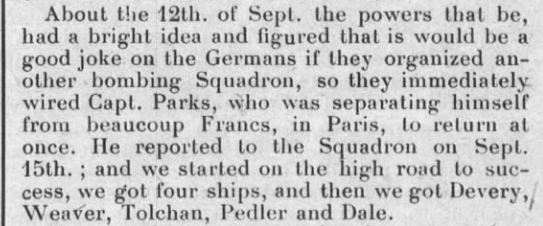
Towards the middle of the month, it was once again decided that the 166th was to be a bombing squadron. Their once and future C.O., Captain Victor Parks, Jr., arrived in mid-September, “and we started on the high road to success, we got four ships, and then we got Devery, Weaver, Tolchan, Pedler and Dale.”17
On September 25, 1917, the squadron moved about thirty miles west to Maulan aerodrome and joined the 1st Day Bombardment Group. The Meuse-Argonne offensive, to which squadrons of the 1st Day were dedicated, began the next day. 166, however, needed time to settle in and do practice sorties before actually taking part in raids. The squadron historian tells of their first mission: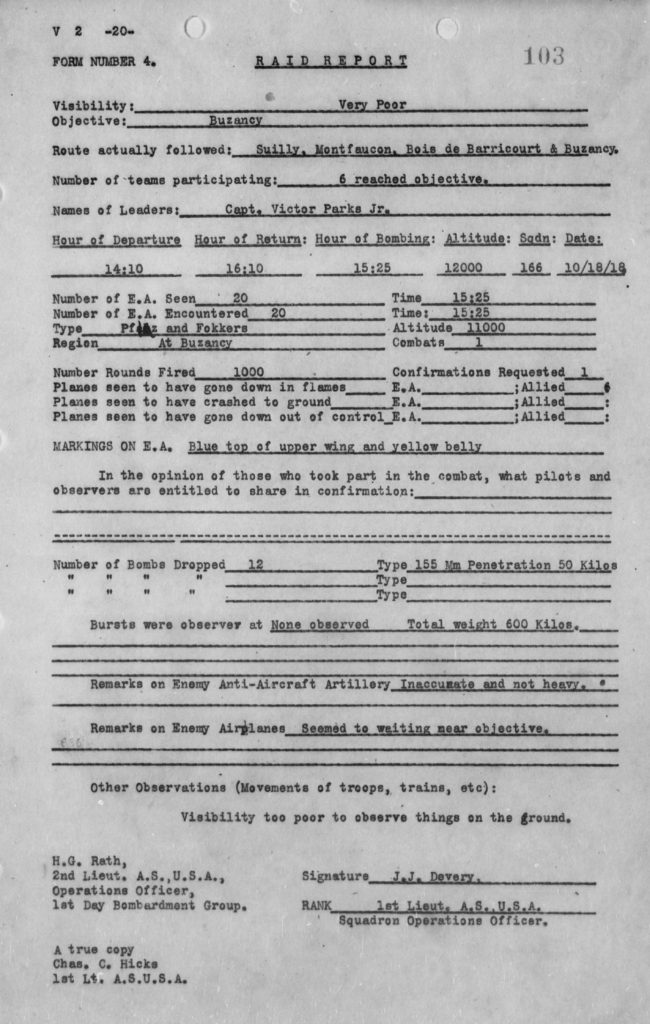
On October 18, 1918, the 166th Aero Squadron made its initial raid. At 14:10 O’Clock thirteen planes took off. The objective was Buzancy. The formation was attacked by a formation of eight Fokkers and in the course of the combat two of our planes were crippled, one with a bullet through the gasoline tank, the other with a disabled engine. Both landed behind our own lines. One enemy aircraft was destroyed and has been Officially [sic] credited.18
Devery, with Ernest Best as his gunner/observer, participated in this raid, carried out jointly with the 96th, 11th, and 20th squadrons, and was among those who reached the objective.19 The “Raid Report” for this and subsequent raid reports through October 30, 1918, were filled out and signed by “J. J. Devery,” as “Squadron Operations Officer” for the 166th.20
Devery’s actions in a raid on October 31, 1918, led to his being awarded a Silver Star Citation. The citation reads in part: “First Lieutenant Devery distinguished himself by gallantry in action while serving with the 166th Aero Squadron, American Expeditionary Forces, in action near Tailly, France, 31 October 1918, while on a raiding mission.”21 During the mission eight Fokkers attacked the planes of the 166th “before reaching objective and continued attack back to the lines.”22 The squadron suffered its only fatality when observer Stanley Lockwood Cochrane was killed by machine gun fire; his pilot, Sam Pickard, was wounded.
According to Rath’s First Day Bombardment Group, Account of Operations, Devery participated in all the raids, sometimes two a day, made by the 166th, except those on November 3, 1918.
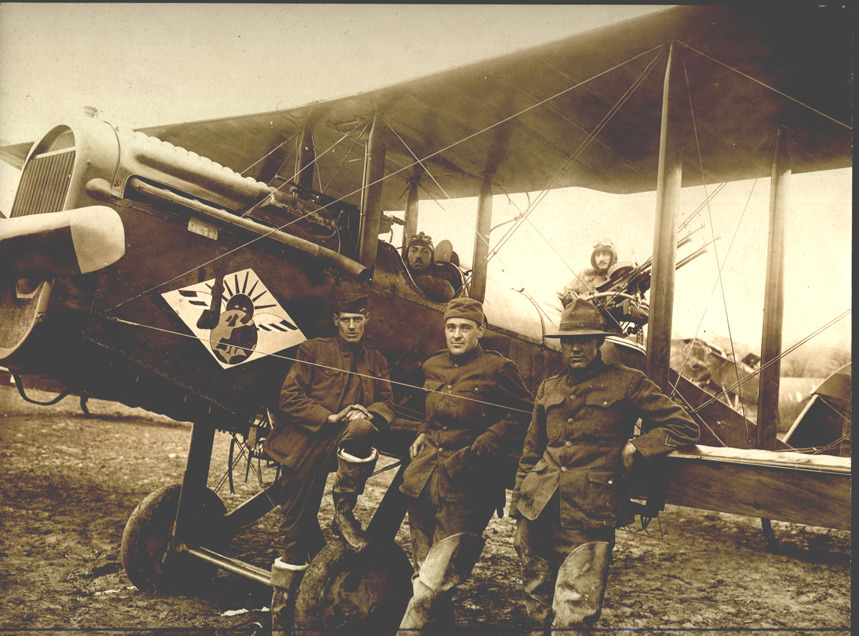
On November 4, 1918, Devery, this time with Henry Irving Jenks as his observer/gunner, took part in the one mission flown, a raid on the railway yards of Montmédy. The narrative account of this raid reads in part “8 E[nemy] A[eroplanes] attacked near Montmedy before reaching objective, 15:15, 1 E.A. went down in flames, another crashed, and one went down out of control. (166th).”23 A General Order dated November 17, 1918, states that “First Lieutenant J. J. Devery and Second Lieutenant A. Tolchan, H. I. Jenks and H. Feinstein, 166th Aero Squadron, 1st Day Bombardment Group, are hereby credited with the destruction, in combat, of an enemy Fokker, in the region of Vigneul, at 12000 feet altitude, on November 4th, 1918, at 15:13 o’clock.”24
Devery, again with Jenks, took part in the First Day Bombardment Group’s final raid on November 5, 1918, but, like nearly half of the 166th’s teams that day, did not reach Mouzon, their objective. Devery appears in photos of the men of the 166th that were presumably taken at Maulan around the time of the armistice.
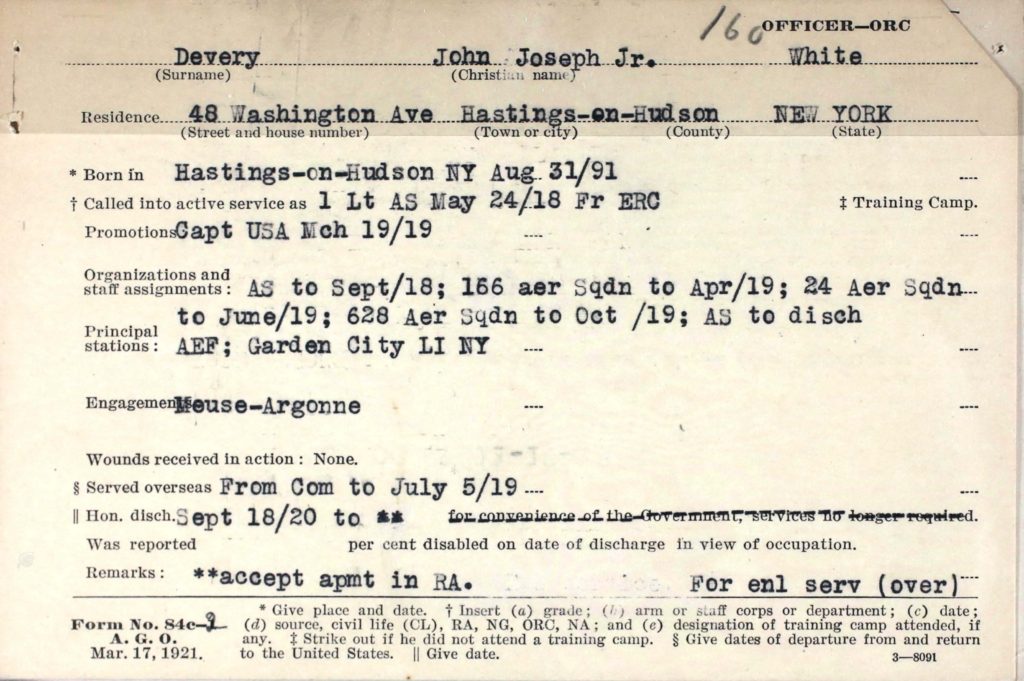
After the armistice Devery remained with the 166th, now reassigned to the U.S. Third Army, which was charged with the occupation of the Rhineland. On March 19, 1919, he was promoted to Captain. In April he was reassigned to the 24th Aero Squadron, also with the Third Army. At the end of June 1919 he sailed home on the U.S.S. Leviathan, arriving at Hoboken on July 5, 1919. He served with the 628th Aero through October 1919.25 He continued in the Aviation Service as a mechanics and flying instructor at various stations, lastly Bolling Field in Washington, D.C. He resigned in early 1930 to go into private aviation.26 Not long afterwards, he moved to Florida, where he resided until his death in 1949.27
mrsmcq June 20, 2017
Notes
(For complete bibliographic entries, please consult the list of works and web pages cited.)
1 Devery’s place and date of birth are taken from Ancestry.com, U.S., World War I Draft Registration Cards, 1917-1918, record for John Joseph Devery. His place of death is taken from Ancestry.com, Florida Death Index, 1877-1998, record for John Joseph Devery Jr; the date of death taken Ancestry.com, U.S., Social Security Applications and Claims Index, 1936-2007, record for John Joseph Devery Jr. The photo is a detail from a photo of football players at Grantham at Thanksgiving
2 “John J. Devery.”
3 “River View Manor and Hastings Happenings,” probably October 1917.
4 The National Archives (United Kingdom), Royal Air Force officers’ service records 1918-1919, record for John Joseph Devery.
5 “Ground School Graduations [for August 25, 1917].”
6 “Hastings Man Marries.” His wife’s name is given in this article as “Cullerton,” but it was probably “Culleton.”
7 Deetjen, Diary, entry for September 23, 1917.
8 Chalaire, “Thanksgiving Day with the Aviators Abroad.”
9 Ludwig’s diary entry for November 29, 1917, lists the “Unfit” team members.
10 Foss, “Cadets of Italian Detachment Posted Dec 3rd” (in Foss, Papers).
11 Kilduff, “Clayton Knight,” pp. 198-99. There is a group photo that includes Devery on p. 200.
11a Knight, cited in Kilduff, “Clayton Knight,” p. 203.
11b Rex, World War I Diary, entry for February 21, 1918.
12 Devery’s R.A.F. service record notes “Bde N E ff Pool,” on March 9, 1918.
13 Cables 874-S and 1303-R; Ancestry.com, New York, Abstracts of World War I Military Service, 1917-1919, record for John Joseph Devery Junior. See here regarding the “non-flying” status stipulated in 874-S. And see McAndrew, “Special Orders No. 147″ and “Special Orders No. 205″ regarding active duty.
14 See Devery’s R.A.F. service record, cited above.
15 “River View Manor and Hastings Happenings,” probably June 1918.
16 Hicks, “History of Operations of the 166th Aero Squadron,” p. 87 (this page is a roster of officers).
17 “The Squadron has an Eventful History”; quotation taken from the December 7, 1918, issue, p. 3. The last three men were presumably Alexander Tolchan, Russsell Henry Pedler, and Russell R. Dale, all of whom had trained with the R.F.C. in Canada; see Sloan, Wings of Honor, pp. 223-36.
18 Hicks, “History of Operations of the 166th Aero Squadron,” p. 85.
19 Rath, First Day Bombardment Group, Account of Operations, p. 130. (Rath lists ten, not thirteen, planes from 166.)
20 See documents appended to Hicks, “History of Operations of the 166th Aero Squadron.”
21 “John Devery.” I have not found any further description of the actions that led to this award.
22 Rath, First Day Bombardment Group, Account of Operations, p. 142
23 Rath, First Day Bombardment Group, Account of Operations, p. 149.
24 “General Orders . . . ,” p. 137. The last man named was Herman Feinstein.
25 On his post-armistice assignments, see Ancestry.com, New York, Abstracts of World War I Military Service, 1917-1919, record for John Joseph Devery Junior, as well as a letter from him to Leslie A. A. Benson dated August 20, 1919, among the papers in Benson, Leslie A. A. Benson Collection, 1917-1919. See War Department, Office of the Quartermaster General, Army Transport Service, Lists of Incoming Passengers, 1917 – 1938, Passenger list for Brest Casual Company FRS-3-B, for his passage back to the U.S.
26 He appears in a group photo of instructors on p. 26 of Military Training Camps Association, The Mess Kit, which also has a brief article by him on pp. 70-71. See “Notes from Air Corps Fields,” p. 99 on his resignation at Bolling Field. See Ancestry.com, 1930 United States Federal Census, record for John J Devery, on his subsequent occupation.
27 Ancestry.com, Florida, State Census, 1867-1945, record for John J Devery (1935).

